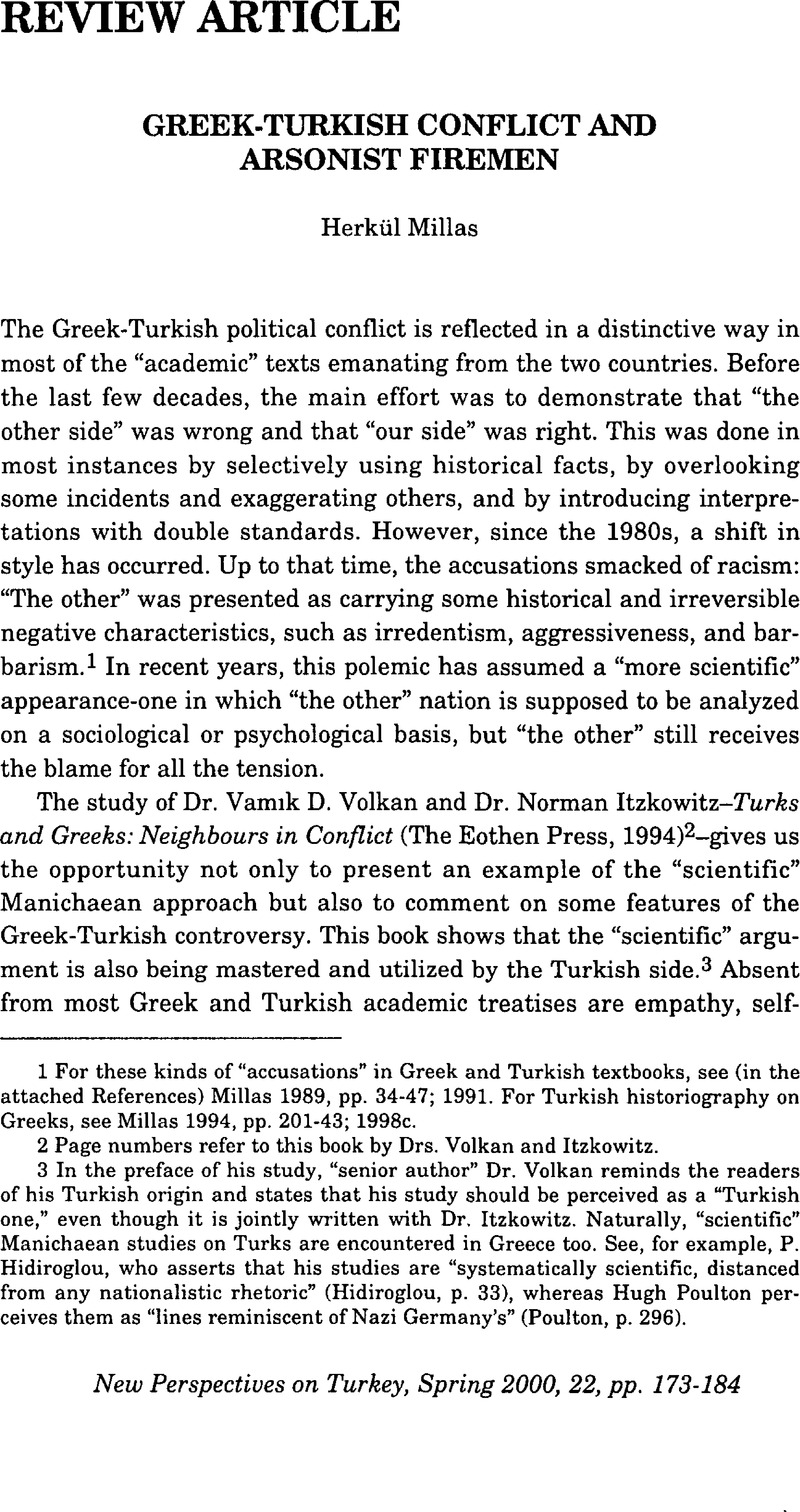No CrossRef data available.
Article contents
Greek-Turkish Conflict and Arsonist Firemen
Published online by Cambridge University Press: 21 July 2015
Abstract
An abstract is not available for this content so a preview has been provided. Please use the Get access link above for information on how to access this content.

- Type
- Review Article
- Information
- Copyright
- Copyright © New Perspectives on Turkey 2000
References
Frangoudaki, A., and Dragona, Th., eds. 1997. Ti Ein' i Patrida mas, Ethnokentris-mos stin Ekpedeusi (What Is Our Motherland? Ethnocentrism in Education). Athens: Aleksandria.Google Scholar
Gellner, Ernest. 1985. The Psychoanalytic Movement or the Coming of Unreason. London: Paladin.Google Scholar
Hidiroglou, Pavios. 1997. I Elliniki Prosengisi tis Turkikis Logotechnias (The Greek Approach to Turkish Literature). Thessalonika: Vanias.Google Scholar
Koulouri, Christina. 1991. Dimensions idéologiques de l'historicité en Grèce 1834-1914. Frankfurt, Bern, New York, Paris: Peterlang.Google Scholar
Millas, Herkül. 1989. Tencere Dibin Kara: Türk Yunan İlişkilerine Bir Önsöz (The Pot Called the Kettle Black: An Introduction to Greek-Turkish Relations). Istanbul: Amaç.Google Scholar
Millas, Herkül. 1991. “History Textbooks in Greece and Turkey,” History Workshop, A Journal of Socialist and Feminist Historians, no. 31 (spring), pp. 21–33.Google Scholar
Millas, Herkül. 1991b. “Türk Edebiyatında Yunan İmajı: Yakup Kadri Kara-osmanoğlu” (“The Image of Greeks in Turkish Literature: Y. К. Karaosmanoglou”). Toplum ve Bilim, no. 51-52 (autumn 1990-winter), pp. 129-52.Google Scholar
Millas, Herkül. 1994. Yunan Ulusunun Doğuşu (The Birth of the Greek Nation). Istanbul: İletişim.Google Scholar
Millas, Herkül. 1994b. “Rumlar” (“The Rums”), Dünden Bugüne İstanbul Ansiklopedisi, vol. 6, pp. 360-68.Google Scholar
Millas, Herkül. 1995. “Türk Kimliği ve Tarihin Kaynaklan” (“The Turkish Identity and the Historical Sources”), Toplumsal Tarih, no. 15 (March), pp. 20–21.Google Scholar
Millas, Herkül. 1996. “Avrupa Birliği, Ahmet Mithat ve Halikarnas Balıkçısı” (“The European Union and H. Balıkçısı”), Toplumsal Tarih, no. 29 (May), pp. 37–40.Google Scholar
Millas, Herkül. 1996b. “Türk Edebiyatında Yunan/Rum İmajı: Ömer Seyfettin” (“The Image of Greeks in Turkish Literature: Ömer Seyfettin”), Kebikeç, no. 3.Google Scholar
Millas, Herkül. 1996c. “The Image of Greeks in Turkish Literature: Fiction and Memoirs,” in Oil on Fire?, ed. Höpken, W.. Hannover: Verlag Hahnsche Buchhandlung.Google Scholar
Millas, Herkül. 1997. “Yurttaş ve Azınlık Olarak İstanbul Rumian” (“The Greeks as Citizens and as a Minority”). Varlık, no. 1073 (February), pp. 5–7.Google Scholar
Millas, Herkül. 1997b. “I Ellinoturkikes Shesis ke emis” (“Greek-Turkish Relations and Us”), Kiryakatiki Avgi-Enthemata, 6 April.Google Scholar
Millas, Herkül. 1997c. “O Kathimerinos mas Tourkos” (“Our Daily Turk”), Kiryakatiki Avgi-Enthemata. 28 December.Google Scholar
Millas, Herkül. 1998. “I Diskolies mias Gnorimias” (“The Difficulties of an Acquaintance”), Kiryakatiki Avgi-Enthemata. 11 October.Google Scholar
Millas, Herkül. 1998b. “I Diskolies mias Gnorimias, 2” (“The Difficulties of an Acquaintance, 2”), Kiryakatiki Avgi-Enthemata. 8 November.Google Scholar
Millas, Herkül. 1998c. “Türk Ders Kitaplarında Yunanlılar: Bütünleştirici Bir Yaklaşım” (“Greeks in Turkish Textbooks: The Way to an Integ-rationary Approach”), in Tarih Eğitimi ve Tarihte ‘Öteki’ Sorunu. Istanbul: Tarih Vakfı Yurt Yayınları.Google Scholar
Millas, Herkül. 1998d. Türk Edebiyatında Yunanlı'nın İmajı, Karşılaştırmalı Bir Yöntemle Ulusçuluk ve Kimlik Sorunları (The Image of Greeks in Turkish Literature: Nationalism and Identity Issues with a Comparative Method). Ph. D. diss., Ankara University (to be pub¬lished by Sabancı University Press in February 2000).Google Scholar
Millas, Herkül. 1998e. Ayvalık ve Venezis: Yunan Edebiyatında Türk İmajı (Ayvalık and Venezis: The Image of the Turk in Greek Literature). Istanbul: İletişim.Google Scholar
Millas, Herkül. 1998f. “Ulusal Kimlikler: Türkler, Yunanlılar ve Edebiyat Metinleri” (“National Identities: Turks, Greeks and Literary Texts”), Defter, no. 32 (winter), pp. 27–34.Google Scholar
Millas, Herkül. 1998g. “1998 Yunanistan Basınında Türkiye” (“Turkey in the Press of Greece in 1998”), in Bilanço 1923-1998, vol. 1. Istanbul: Tarih Vakfı.Google Scholar
Millas, Herkül. 1999. “Türk ve Yunan Romanları, Kadınları ve İlişkileri” (“Les Romans, Les Femmes et Les Relations Greco-Turques.”). Genese / Oluşum, no. 60-61 (May-August), pp. 46–64.Google Scholar
Millas, Herkül. and Balta, E.. 1996. “1923 Mübadelesinin Tarihsel Sorunları: Bir Destan ve Sözlü Tarih” (“The Historical Problems of the Exchange of 1923: An Epic Poem and Oral History”), Tarih ve Toplum, no. 149 (May), pp. 5–15.Google Scholar
Pesmazoglou, Stefanos. 1993. Europi-Tourkia (Europe-Turkey), 2 vols. Athens: Themelio.Google Scholar
Poulton, Hugh. 1997. Turkish Nationalism and the Turkish Republic: Top Hat, Grey Wolf and the Crescent. London: Hurst and Company.Google Scholar
Seton-Watson, H. 1988. “On Trying to be a Historian of Eastern Europe,” in Historians as Nation Builders, ed. Deletant, D. and Hanak, H.. London: School of Slavonic and East European Studies.Google Scholar
Volkan, Vamık, and Itzkowitz, Norman. 1994. Turks and Greeks: Neighbours in Conflict. Cambridgeshire: The Eothen Press.Google Scholar




